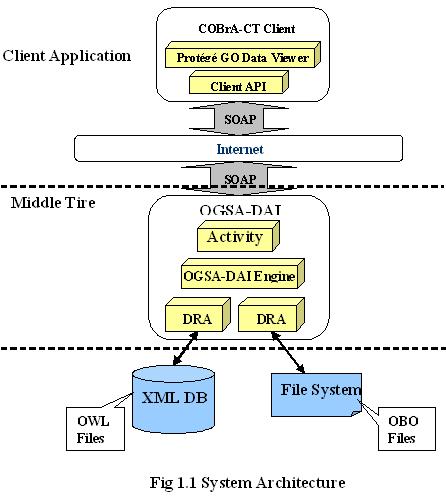Home
Tools
Downloads
Publications
Links
Stuart Aitken
Email:
stuart@aiai.ed.ac.uk
Yin Chen
Email:
ychen3@inf.ed.ac.uk
Artificial Intelligence Applications Institute
The University of
Edinburgh
Appleton Tower
Crichton St
Edinburgh EH8 9LE
United Kingdom
Updated: Fri Jan 19 19:57:42 GMT 2007
|
|
Links: Grid-Enabling COBrA-CT
|
|
|
|
In the past few
years, the grid has attracted enormous
attention and gained popularity by supporting distributed resources
sharing and
aggregation across large scale, multiple administrative virtual
organizations
in science and business. Compared to the web, the grid offers upgraded
performance in terms of security, fault tolerance, scalability,
providing a dynamic, heterogeneous environment.
By enabling COBrA-CT to operate through the Grid,
the software capabilities are expected to be enhanced greatly.
One of
simplest
ways to Grid-enable COBrA-CT is to
assemble OGSA-DAI with COBrA-CT. Aimed to assist with access and
integration of
distributed data resources via the grid, OGSA-DAI provides various
interfaces
supporting data operation, transforming and delivering with many
popular
(relational or XML) databases, such as Oracle, DB2, SQL Server, MySQL,
Xindice,
eXist etc., and file systems, such as CSV, BinX, EMBL, OMIM etc.
Wrapped by
OGSA-DAI, a data resource can be deployed within a Grid environment,
thereby
provides a means for user to expose their web applications onto Grids.
Projects
that employee OGSA-DAI middleware including, myGrid, Biogrid,
OGSA-WebDB, GEON,
etc. appeared to be successful.
|
|
|
We propose
to use OGSA-DAI middleware to glue XML database
and Protégé client GO data viewer in COBrA-CT system. The
reasons are as
follows,
- It is a simple
method to add features of the grid to COBrA-CT, to improve the software
capabilities in terms of scalability, security, high performance, etc.
- OGSA-DAI
provides interface to interact with XML database (Apache Xindice and
eXist), data operations are straightforward.
- It may reduce
our development task greatly;
- Reusing fully
tested software could reduce test task of the new software and enhance
code quality.
System
Architecture
As shown in the
Fig 1.1, the client API will be
implemented which can be plug-in to Protégé. It
responds for triggering
OGSA-DAI activities, uploading OG data, and receiving return
data sets.
GSA-DAI Activities are
the operations that a data service resource can perform, including data
resource
manipulation, data transformation and data delivery operations.
The interactions
of OGSA-DAI activities is illustrated by
Fig 1.2 On receiving request from client, activities invoke Data
Resource
Accessor’s (DRA) methods to connect with specific data resources, and
return
response message in a form of XML document.
Two
type of XML data resources are supported by current
OGSA-DAI release, Xindice and eXist. OGSA-DAI provide DRA to interact
with
these databases.

Unfortunately,
current version of OGSA-DAI doesn’t support
Berkeley XML Database. Following table shows parts of features of three
XML
databases products.
|
|
Berkeley
XML DB
|
Apache
Xindice
|
eXist
|
|
Supporting
Query Language
|
XQuery ,
XPath
|
XPath,
XUpdate
|
XUpdate,
XPath XQuery
|
|
Documents
size
|
Large size
|
Small to
medium sized
|
Not
mention
|
|
Update
|
Document
level
|
Document-level
Node-level
|
Document-level
Node-level
|
|
Support
File Types
|
Both XML
and non-XML documents
|
Only XML
documents
|
|
|
Deployment
|
Stand-along
DB
Java
Library
|
Stand-along
DB
Java
Library
Servlet
|
Stand-along
DB
Java
Library
Servlet
|
Fig 1.3 Comparison of
Berkeley XML DB, Apache Xindice and eXist
Initial
investigation shows Xindice and eXist probably be
able to serve our basic requirements, storing and loading OG data.
However, we
concern about capabilities of both products for handling large size of
XML
documents. To take the advantage of existing OGSA-DAI technologies, we
suggest,
at the first development stage, to employee Xindice or eXist XML
Database.
OGSA-DAI may have plans to improve XQuery capabilities in their release
9 in
October 2006. We will push their action to support Berkeley XML DB
interaction.
If it happens, we expect the later tasks of switching to Berkeley XML
DB would
not be difficult.
|
|
